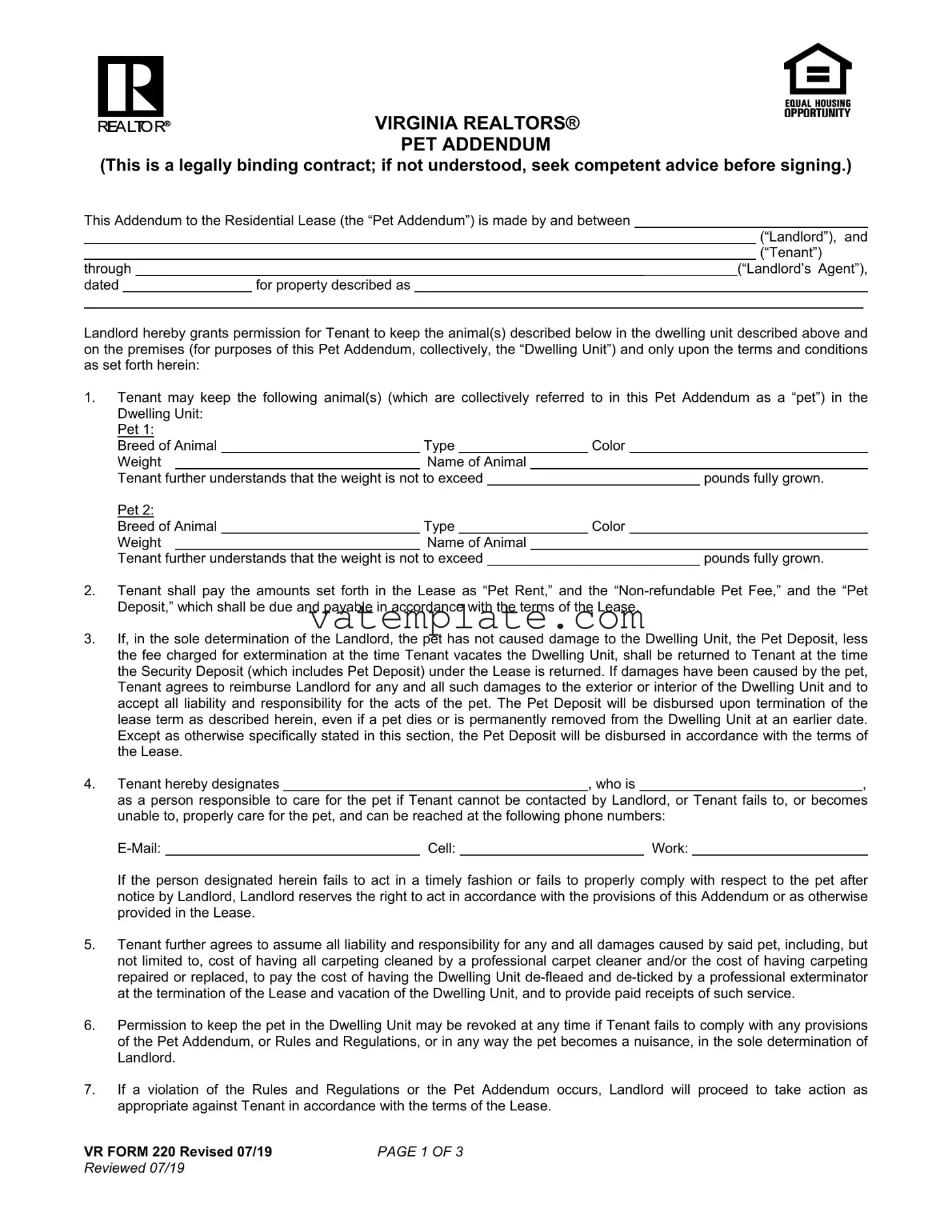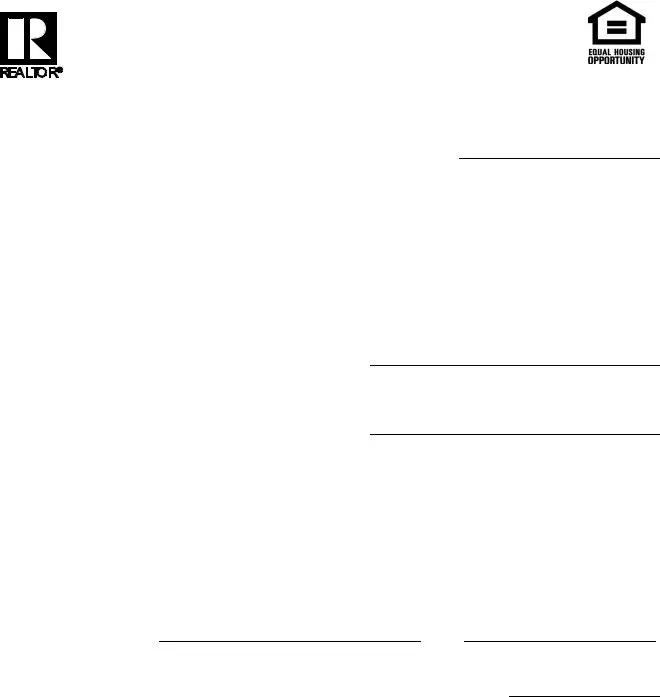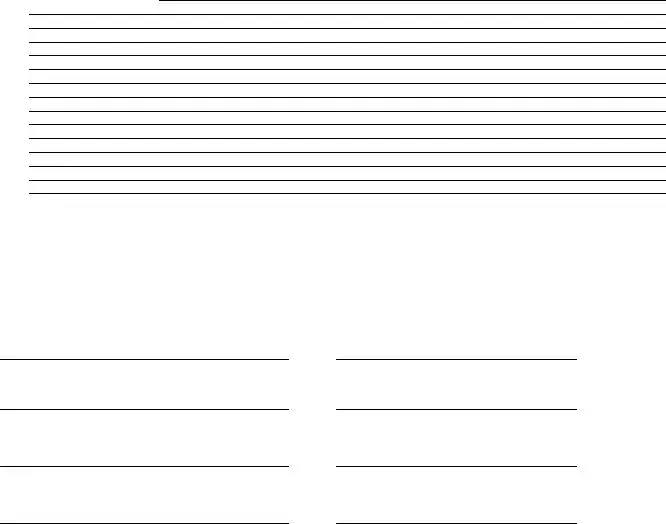VIRGINIA REALTORS®
PET ADDENDUM
(This is a legally binding contract; if not understood, seek competent advice before signing.)
This Addendum to the Residential Lease (the “Pet Addendum”) is made by and between
|
|
|
|
|
|
|
|
|
|
|
|
|
|
(“Landlord”), and |
|
|
|
|
|
|
(“Tenant”) |
through |
|
|
|
____________(“Landlord’s Agent”), |
dated |
|
for property described as |
|
|
|
|
|
|
_____________________ |
|
Landlord hereby grants permission for Tenant to keep the animal(s) described below in the dwelling unit described above and on the premises (for purposes of this Pet Addendum, collectively, the “Dwelling Unit”) and only upon the terms and conditions as set forth herein:
1.Tenant may keep the following animal(s) (which are collectively referred to in this Pet Addendum as a “pet”) in the Dwelling Unit:
|
|
|
|
|
|
|
|
|
Pet 1: |
|
|
|
|
|
|
|
Breed of Animal |
|
Type |
Color |
Weight |
|
Name |
of Animal |
|
|
|
Tenant |
further understands that the weight is not |
to exceed |
|
|
pounds fully grown. |
Pet 2: |
|
|
|
|
|
|
|
Breed of Animal |
|
Type |
Color |
Weight |
|
Name |
of Animal |
|
|
|
Tenant |
further understands that the weight is not |
to exceed |
|
|
|
pounds fully grown. |
2.Tenant shall pay the amounts set forth in the Lease as “Pet Rent,” and the “Non-refundable Pet Fee,” and the “Pet Deposit,” which shall be due and payable in accordance with the terms of the Lease.
3.If, in the sole determination of the Landlord, the pet has not caused damage to the Dwelling Unit, the Pet Deposit, less the fee charged for extermination at the time Tenant vacates the Dwelling Unit, shall be returned to Tenant at the time the Security Deposit (which includes Pet Deposit) under the Lease is returned. If damages have been caused by the pet, Tenant agrees to reimburse Landlord for any and all such damages to the exterior or interior of the Dwelling Unit and to accept all liability and responsibility for the acts of the pet. The Pet Deposit will be disbursed upon termination of the lease term as described herein, even if a pet dies or is permanently removed from the Dwelling Unit at an earlier date. Except as otherwise specifically stated in this section, the Pet Deposit will be disbursed in accordance with the terms of the Lease.
4. Tenant hereby designates, who is,
as a person responsible to care for the pet if Tenant cannot be contacted by Landlord, or Tenant fails to, or becomes unable to, properly care for the pet, and can be reached at the following phone numbers:
If the person designated herein fails to act in a timely fashion or fails to properly comply with respect to the pet after notice by Landlord, Landlord reserves the right to act in accordance with the provisions of this Addendum or as otherwise provided in the Lease.
5.Tenant further agrees to assume all liability and responsibility for any and all damages caused by said pet, including, but not limited to, cost of having all carpeting cleaned by a professional carpet cleaner and/or the cost of having carpeting repaired or replaced, to pay the cost of having the Dwelling Unit de-fleaed and de-ticked by a professional exterminator at the termination of the Lease and vacation of the Dwelling Unit, and to provide paid receipts of such service.
6.Permission to keep the pet in the Dwelling Unit may be revoked at any time if Tenant fails to comply with any provisions of the Pet Addendum, or Rules and Regulations, or in any way the pet becomes a nuisance, in the sole determination of Landlord.
7.If a violation of the Rules and Regulations or the Pet Addendum occurs, Landlord will proceed to take action as appropriate against Tenant in accordance with the terms of the Lease.
VR FORM 220 Revised 07/19 |
PAGE 1 OF 3 |
Reviewed 07/19 |
|
8.In addition to Landlord’s right to make other inspections as provided in the Lease, if Landlord receives a written complaint alleging a pet violation, or otherwise has reasonable cause to believe a pet violation has occurred, Landlord may enter the Dwelling Unit after the giving of reasonable notice to Tenant. Any such inspection, unless in case of emergency, will be conducted during normal business hours.
In case of emergency, or if the pet becomes vicious, displays symptoms of severe illness, or demonstrates other behavior which constitutes an immediate threat to the health and safety as a whole, Landlord may enter the Dwelling Unit immediately, remove, or cause removal of, the pet and further take action with respect to the pet as is permissible under Virginia or local law. If Landlord places the pet in a facility or shelter, Tenant will be responsible for payment of all applicable costs and expenses. Landlord is authorized to take this action under this section only when Landlord requests the Tenant to take corrective action and the Tenant fails to do so in a timely fashion, when Landlord is unable to contact the Tenant after reasonable efforts to do so, or in cases of emergency in Landlord’s sole determination. Landlord and Agent shall not be liable under any circumstances for any actions taken pursuant to this section. Tenant further hereby releases Landlord and Agent from any and all liability and agrees to indemnify Landlord and Agent from any claims, damages or losses whatsoever resulting from the Tenant maintaining the pet in the Dwelling Unit.
9.Pets shall be categorized as follows:
a.Ordinary house pets shall include dogs, cats, caged domesticated birds, hamsters, gerbils, and guinea pigs, aquarium fish, small turtles and tortoises, so long as such animals are normally maintained in a terrarium or aquarium. Only ordinary house pets shall be permitted in the Dwelling Unit, subject to these guidelines.
b.Unusual house pets are prohibited, and shall include without limitation, those animals not generally maintained in dwelling units such as large reptiles, snakes, anthropoids, felines other than domestic cats, canines other than dogs, rodents, mammals, birds, and other creatures other than those listed in subsection (a) above.
10.The number of ordinary house pets must be approved in advance and in writing by the Landlord. No other animal besides the pet expressly authorized by this Pet Addendum shall be allowed in the Dwelling Unit. If Tenant wishes to add another animal to the Dwelling Unit during the term of the Lease, Tenant must obtain prior approval for such pet in accordance with this Pet Addendum.
11.If the Dwelling Unit is part of an apartment community, pets may eliminate waste only in the areas defined as “Pet Areas.” Pet owners are responsible for the immediate removal and proper disposal of pet waste on all portions of the property, including Pet Areas. Generally, Pet Areas are defined as follows:
a.Areas away from buildings, walkways, patio areas, picnic and play areas, and the amenities area;
b.Any “dog run” that may be available at the apartment community; and
c.Such other areas defined by the Landlord.
12.If the Dwelling Unit is part of an apartment community, pets shall not be permitted upon the common areas of the property unless they are carried or leashed, or unless in a dog run. No leash may exceed six feet in length. No pet may be leashed to any stationary object on the common elements. Pets shall not be permitted in the pool or on the grounds contiguous to the pool.
13.If the Dwelling Unit is part of an apartment community and if pet runs are available, the dog is permitted to be without a leash within the specified area designated as a dog run. However, no Prohibited Dogs are allowed in the dog run at any time. Tenant shall remain with the dog in the dog run, and supervise the dog’s conduct. Tenant is responsible for the conduct of the dog at all times while in the dog run.
14.If the Dwelling Unit is not part of an apartment community, Tenant is responsible for the immediate removal and proper disposal of pet waste on all portions of the property
15.Tenant shall ensure that the pet shall not bite, injure or harm any individual or other animal, and shall not disturb others or cause damage to the Dwelling Unit or the premises. If, in Landlord or Agent’s opinion, the pet has injured or disturbed others, or has damaged property, Tenant must permanently remove the pet within 15 days (or sooner in the case of an emergency) of receiving written notice, and failure to do so shall constitute a violation of the Lease, and may subject Tenant to eviction. Tenant is responsible for any property damage, injury, or disturbances the pet may cause or inflict.
16.Commercial breeding of animals is prohibited.
17.All pets must have and display, as appropriate, evidence of all required registrations and inoculations.
VR FORM 220 Revised 07/19 |
PAGE 2 OF 3 |
Reviewed 07/19 |
|
18.Pets shall not be left unattended outside the Dwelling Unit.
19.Tenant shall not inflict or cause cruelty in connection with any pet.
20.Landlord reserves the right to require Tenant to maintain liability insurance for the pet identified in this Pet Addendum.
21.OTHER PROVISIONS:
The Lease, including any other applicable addenda, as written, is all inclusive and binding to Landlord and Tenant, with the exception of the amendments and/or revisions contained herein.
IN WITNESS WHEREOF, the parties have executed the Pet Addendum on the dates reflected below:
Tenant:
/
Date Signature
/
Date Signature
/
Date Signature
/
Date Signature
Landlord (or duly authorized agent):
/
Date Signature
/
Date Signature
/
Date Signature
/
Date Signature
COPYRIGHT© 2019 by Virginia REALTORS®. All rights reserved. This form may be used only by members in good standing with Virginia REALTORS®. The reproduction of this form, in whole or in part, or the use of the name "Virginia REALTORS®, in connection with any other form, is prohibited without prior consent from Virginia REALTORS®.
VR FORM 220 Revised 07/19 |
PAGE 3 OF 3 |
Reviewed 07/19 |
|


